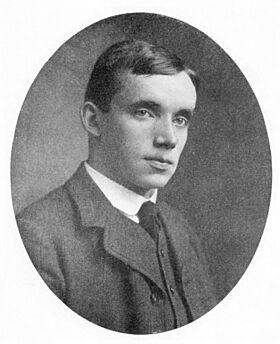James Bridie facts for kids
James Bridie (born January 3, 1888, in Glasgow – died January 29, 1951, in Edinburgh) was the pen name of a Scottish writer and doctor. His real name was Osborne Henry Mavor. He chose his pen name by combining his grandfather's first name and his grandmother's maiden name.
About James Bridie
James Bridie was the son of Henry Alexander Mavor, who was an electrical engineer. He went to school at The Glasgow Academy and then studied medicine at the University of Glasgow. He became a doctor in 1913.
During World War I, he worked as a military doctor in France and Mesopotamia. After the war, he became a general doctor and later a professor.
He became well-known for his funny play The Anatomist (1931). This play was about the famous grave robbers Burke and Hare. His plays were very successful in London, and he became a full-time writer in 1938. He also served as a doctor again during World War II.
In 1923, he married Rona Locke Bremner. Their son sadly died during World War II. His other son, Ronald, also became a doctor and a writer. Ronald later worked as a drama critic and helped lead the Scottish Arts Council.
James Bridie passed away in Edinburgh from a stroke. He is buried in Glasgow's Western Necropolis. The Bridie Library at the Glasgow University Union is named after him, as is an annual dinner held there every December.
His Impact on Arts and Theatre
James Bridie played a big part in Scottish theatre. He helped start the Citizens Theatre in Glasgow. He worked with Dr. Tom Honeyman and George Singleton, who also created the Cosmo cinema (now the Glasgow Film Theatre). Many of Bridie's plays were performed at the Citizens Theatre between 1943 and 1960.
Some people say that Bridie's plays shaped Scottish theatre until the 1960s. He also encouraged other Scottish writers like Robert Kemp and Alexander Reid. His plays were both serious and fun. They were popular and made people think.
In 1946, Bridie suggested a Scottish Theatre Festival in Perth. He wanted Scottish theatres to come together there. He was the first chairman of the Arts Council in Scotland. He also helped create the famous Edinburgh Festival. In 1950, he founded the Glasgow College of Dramatic Art. Today, this is part of the Royal Conservatoire of Scotland.
Bridie also worked with the famous film director Alfred Hitchcock in the late 1940s. He helped write screenplays (scripts for movies) for these films:
- The Paradine Case (1947)
- Under Capricorn (1949)
- Stage Fright (1950)


